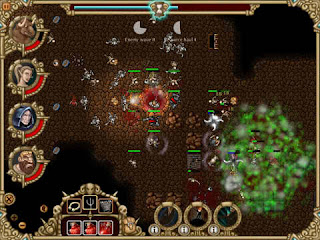There’s still a big market for retro-flavoured RPGs. Stat-crunching, story-light, dungeon hacking RPGs. When done well, it’s a pure kind of game, and, like a good 2D platformer, a throwback to a simpler and more innocent time.
Companions aims to capture that warm, fuzzy nostalgia, and wears its indie nature on its sleeve. It’s not brilliant or a work of art, but as a grind-heavy hack-a-thon, it still provides a good time.
| This game is halfway between two classics: Gauntlet, and Baldur’s Gate |
The key in this game is the interplay between the four main characters, and each of those can have one specialisation. The Minotaur is the burly fighter. The elf is the lithe archer. The human wizard is the frail slow dude everyone needs to protect… until he whips out a fireball, and the dwarf is the engineering fellow. It’s all stereotyped, and why, exactly, they find themselves working together is a bit of back story that is either never explained, or so forgettable that my memory has already trashed it.
But there they are, working together in quite a neat way. Each character’s skills complement the others, so like any good team-based RPG, getting through the more difficult battles requires the intelligent use of each team member.
There’s the occasional bit of dialogue or explanation, but that’s not why anyone is playing the game, and the temptation to just skip through without reading is easy to succumb to. Especially considering smashing skulls is so much fun.
Like RPGs such as Baldur’s Gate, Companions is technically a real-time RPG, but a pause function allows you to play it through almost like a turn-based game. Depending on the difficulty setting, the pause will only last so long and you’ll still need to think fast, but at least that short grace period means you’re not going to get too frustrated with the controls.
Because they’re not very good. Everything is controlled with taps and swipes, but the problems crop up pretty quickly. For instance, scrolling around the map requires two fingers; as someone who is used to scrolling around with just the one, this adjustment took some time to make, and even now feels clunky and unnecessary. Characters are moved around through tapping on them, and then their destination but it’s a ‘sticky’ process that, in the heat of an intense battle, makes things a little frustrating – especially when you need to start working on their facing. Constantly having to touch and drag to move inventory around also becomes quite tiring.
On the plus side, the game looks and sounds the part. Characters have a bright, colourful charm, and for an indie production, the use of music and sound effects is of a very high caliber.
 |
| Poison gas! |
You also get a lot out of this game for the investment. In addition to a decent length campaign, there’s the ability to go back and replay maps for high scores. With both OpenFeint and Game Center integration, getting those high scores can be a very addictive process – especially given how tweakable the game can be.
If you like loot, killing monsters, delving into deep dungeons and retro-flavoured RPGs, you should get a kick out of Companions. It’s never going to win game of the year, but it’s good fun nonetheless.







